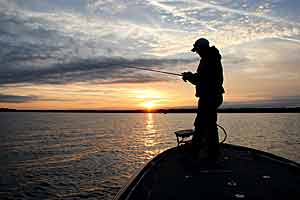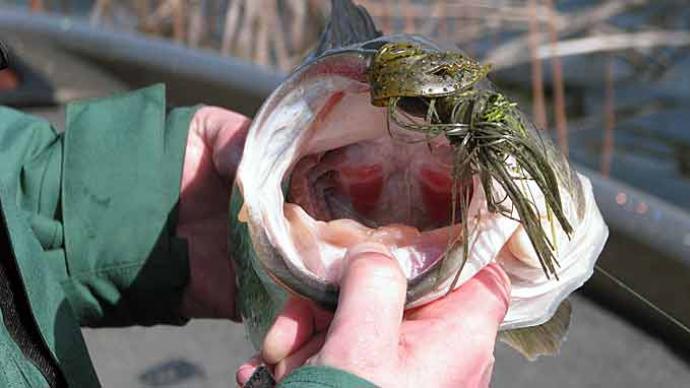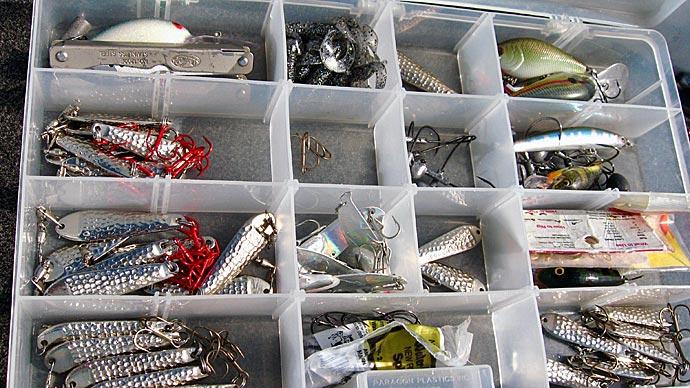
Late one January I had a client who booked a night trip. The weather was very cold, with a chance for snow. That evening everyone at the boat ramp thought we were crazy. So did I. I tried to persuade them to cancel or switch to daytime. They said they had to fish at night due to a skin problem and for me to bundle up and put them on a big fish. I told them we would be lucky if we caught a couple of dinks.
Around 1:30 a.m. I slid the net under a 13.04-pound bass.
Most people think night fishing is good only during summer. The truth is, night fishing for trophy bass is good year round. Even in the spring when the daylight bite is excellent, the night bite can also be good. For this I firmly believe that there are two different groups of feeding bass: one that feeds exclusively during day and the other during the night.
Most anglers prefer night during summer when days are warmer. Pursuing trophy bass after dark can definitely tilt the odds in your favor from June to September. You will consistently catch more of the larger bass during night than you will during the "dog days" of summer.
Preparation is very important before you journey out after dark. Make sure you have a good spotlight, flashlight, and bug repellent (Skin So Soft by Avon is great). Let someone onshore know where you plan to fish and the approximate time of your return. Begin preparation before dark by preparing your rods, reels, and lures before leaving the dock.
Make sure all equipment is working, batteries charged, life preservers and floating devices aboard, and running lights functioning. During daylight, scout and familiarize yourself with the areas you plan to fish. Know the locations of brush lines, breaklines and grassy edges. During daylight, plan and go over your route and mark all hazards. If you have to move from one location to another, don't be in a hurry. If you are not familiar with the lake, fish near your launch site. On lakes with lots of timber, move from one location to another with caution. Also, leave your running lights on when you are fishing or under power. It's the law and a good, safe practice.
The number one thing to remember in night fishing is safety. No fish is worth jeopardizing your safety, those with you, or others on the lake.
From the end of May through summer, the best locations to night fish for trophy bass are basically the same as day fishing. Start your night trip fishing shallow, two to six feet, close to deep water, off points, shallow breaklines, and grassy edges. On dark nights, the fishing may be best near lighted piers, boathouses, and marinas. Concentrate on the piers that are always lighted, especially if they are on or near points, breaklines, or grass. If shallow does not produce, have a deep pattern for backup. Deep at night is 15 to 20 feet.
Fish the deeper, sloping main lake points that extend farther into the lake and have sharp drops along the sides and at the ends. The most productive points will have deep grass or wood structure on, or near, the deeper breaklines.
The primary lures I use for night fishing are those that consistently produce trophy bass such as big plastics, jigs, spinnerbaits, and buzzbaits. By big plastics, I mean 10- to 15-inch worms and 8- to 9-inch lizards and Hawg Craws. Colors should be on the dark side such as red shad, black, and blue.
Spinnerbaits and buzzbaits will produce some trophy fish, especially in May and June. You need only two colors, black or black/blue. The recommended spinner size is the #4 to#6 Colorado blade because it is easier to feel the thumping of the blade. For buzzbaits, any large blade will do.
A 1/2-ounce Penetrator Twin Skin jig in black and blue with a Gene Larew black/blue Hawg Craw is my number one consistent producer of big fish at night on Lake Fork. Experienced night anglers know these baits are all you need to consistently catch trophy bass at night.
As a rule, for night fishing, dark colors work best. However, I'll let you in on a tip when the bite is slow. One night a few years ago during a slow bite, a past client was fishing in the same area we were fishing. He was in a one-man bass buggy throwing a solid white crankbait. He was catching good bass about every other cast. After watching and hearing him catch 10 bass to our one, I started scouring my tackle box for any crankbait in white. I did not have any white cranks, but did find a white jig and craw and my clients caught bass the remainder of the night. White crankbaits and white jig and craw are now a major part of my night arsenal. When the bite is slow, experiment with different colors, it could pay off. The 13.04 bass previously mentioned came on a white jig and craw.



